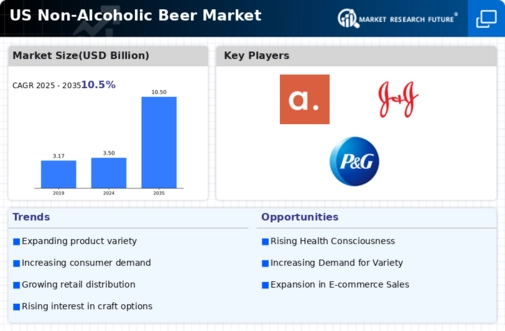Health and Wellness Trends
The non alcoholic-beer market is closely aligned with the prevailing health trends that dominate consumer behavior. As individuals become more health-conscious, they are actively seeking beverages that align with their lifestyle choices. This trend is reflected in the increasing demand for non alcoholic options that offer lower calories and no alcohol content. Recent surveys indicate that nearly 60% of consumers are more inclined to choose non alcoholic beverages that promote health benefits. This growing preference is likely to drive innovation within the non alcoholic-beer market, as brands respond by developing products that cater to health-oriented consumers, thereby expanding their market reach.
Expansion of Retail Channels
The non alcoholic-beer market is witnessing an expansion of retail channels, crucial for increasing product accessibility. Traditional grocery stores, convenience stores, and online platforms are increasingly stocking a variety of non alcoholic beer options, catering to the evolving preferences of consumers. Data from industry reports indicates that sales through e-commerce channels have grown by over 25% in the past year, reflecting a shift in shopping habits. This diversification in retail presence not only enhances consumer convenience but also encourages trial among new customers. As more retailers recognize the potential of the non alcoholic-beer market, the availability of these products is expected to increase, further driving market growth.
Focus on Craft and Local Brands
The non alcoholic-beer market is experiencing a growing interest in craft and local brands, which appeal to consumers seeking unique flavors and authentic experiences. This trend is indicative of a broader movement towards supporting local businesses and artisanal products. Recent statistics show that craft non alcoholic beers have captured a significant share of the market, with sales increasing by approximately 30% over the last year. Consumers are drawn to the story behind these brands, often valuing quality and craftsmanship over mass-produced alternatives. This focus on local and craft offerings is likely to continue shaping the non alcoholic-beer market, as consumers increasingly prioritize authenticity in their beverage choices.
Innovative Marketing Strategies
The non alcoholic-beer market is benefiting from innovative marketing strategies that resonate with a diverse consumer base. Brands are increasingly leveraging social media platforms and influencer partnerships to promote their products, effectively reaching younger demographics who prioritize lifestyle choices. This approach appears to be effective, as recent surveys suggest that nearly 40% of consumers aged 21-34 are more likely to purchase non alcoholic options when they are marketed as trendy and socially acceptable. Additionally, the use of creative packaging and branding has enhanced the visibility of non alcoholic beers, making them more appealing to consumers. As a result, the market is likely to see continued growth driven by these strategic marketing efforts.
Rising Demand for Alcohol Alternatives
The non alcoholic-beer market is experiencing a notable surge in demand as consumers increasingly seek alternatives to traditional alcoholic beverages. This shift is driven by a growing awareness of health and wellness, with many individuals opting for non alcoholic options to reduce alcohol consumption while still enjoying social experiences. Recent data indicates that the market for non alcoholic beverages in the US has expanded significantly, with sales projected to reach approximately $1.5 billion by 2025. This trend reflects a broader cultural movement towards moderation and responsible drinking, positioning the non alcoholic-beer market as a viable choice for consumers looking to balance enjoyment with health considerations.














Leave a Comment